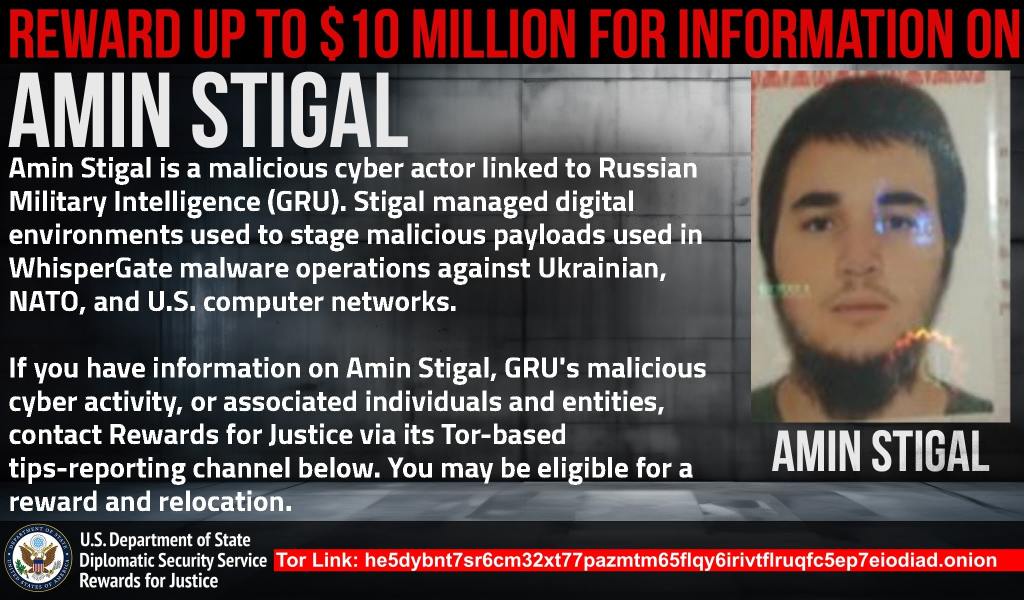Russian Man Indicted For Cyberattacks Targeting Ukraine, US

22 year-old Amin Stigal allegedly also helped in scanning vulnerabilities, mapping networks, and identifying potential website vulnerabilities in U.S.-based critical infrastructure – particularly the energy, government, and aerospace sectors.
Mihir Bagwe June 26, 2024

Share on LinkedInShare on Twitter
A U.S. grand jury has indicted a Russian citizen, Amin Timovich Stigal, for allegedly conspiring with Russia’s military intelligence agency (GRU) to launch cyberattacks crippling Ukrainian government systems and data ahead of Russia’s full-scale invasion in February 2022.
The indictment, unsealed yesterday in Maryland, sheds light on a coordinated effort to disrupt critical Ukrainian infrastructure and sow panic among the population.
“As alleged, the defendant conspired with Russian military intelligence on the eve of Russia’s unjust and unprovoked invasion of Ukraine to launch cyberattacks targeting the Ukrainian government and later targeting its allies, including the United States.” – Attorney General Merrick B. Garland
Attacker Aimed for ‘Complete Destruction’ in Cyberattacks Targeting Ukraine
Stigal, 22, who remains at large, was charged for his alleged role in using a deceptive malware strain called “WhisperGate” to infiltrate dozens of Ukrainian government networks, including ministries, state services, and critical infrastructure entities. Disguised as ransomware, WhisperGate reportedly went beyond data encryption, aiming for complete destruction of targeted systems and data.
The attacks coincided with the defacement of Ukrainian websites displaying threatening messages designed to intimidate the public. Sensitive data, including patient health records, was exfiltrated and offered for sale online, further amplifying the chaos.
U.S. Critical Infrastructure Targeted Too
But the malicious campaign wasn’t limited to cyberattacks targeting Ukraine. The indictment broadens the scope beyond Ukraine, revealing attempts to probe U.S. government networks in Maryland using similar tactics.
“These GRU actors are known to have targeted U.S. critical infrastructure. During these malicious cyber activities, GRU actors launched efforts to scan for vulnerabilities, map networks, and identify potential website vulnerabilities in U.S.-based critical infrastructure – particularly the energy, government, and aerospace sectors.” – Rewards for Justice
The scope of the malicious campaign highlights the potential wide-ranging objectives of the GRU cyber campaign and the ongoing threat posed by nation-state actors.
Reward Offered for Info Leading to Capture
The Justice Department emphasized its commitment to holding accountable those responsible for Russia’s malicious cyber activity. The indictment carries a maximum sentence of five years, but international cooperation remains crucial to apprehend Stigal.
The U.S. Department of State’s Rewards for Justice program is offering a significant reward – up to $10 million – for information leading to Stigal’s capture or the disruption of his cyber operations. This substantial reward underscores the seriousness of the charges and the international effort to dismantle Russia’s cyber warfare apparatus.
This case serves as a stark reminder of the evolving cyber threat landscape. The destructive capabilities of malware like WhisperGate, coupled with the targeting of critical infrastructure necessitates vigilance and collaboration between governments and security professionals to defend against nation-state cyberattacks.
“Malicious cyber actors who attack our allies should know that we will pursue them to the full extent of the law,” said Erek L. Barron, U.S. Attorney for the District of Maryland. “Cyber intrusion schemes such as the one alleged threaten our national security, and we will use all the technologies and investigative measures at our disposal to disrupt and track down these cybercriminals.”
Who is Amin Stigal?
The U.S. linked 22-year-old Amin Stigal to the Russian GRU and labelled him for his involvement in the WhisperGate malware operations. But who is Amin Stigal and what is the extent of his involvement.

The U.S. authorities along with the $10 million bounty released scarce but very important details on Stigal’s cyber trail – his aliases or the threat group names with whom he is affiliated. The Cyber Express did an open-source intelligence (OSINT) study on these aliases and found the following details on Amin Stigal’s cyber activities:
DEV-0586/Cadet Blizzard
Microsoft first tracked this threat actor as DEV-0586 and observed its destructive malware targeting Ukrainian organizations in January 2022. The tech giant later in April 2023 shifted to a new threat actor naming taxonomy and thus named the TA “Cadet Blizzard.”
Cadet Blizzard has been operational since at least 2020 and has initiated a wave of destructive wiper attacks against Ukraine in the lead up to the Russia’s February 2022 invasion of Ukraine. Specifically, it created and developed WhisperGate, a wiper that deletes the master boot record, Microsoft said.
EMBER BEAR
Crowd Strike tracked this threat actor as EMBER BEAR (aka Lorec Bear, Bleeding Bear, Saint Bear) and linked it to an adversary group that has operated against government and military organizations in eastern Europe since early 2021. The likely motive of this TA is to collect intelligence from target networks, the cybersecurity firm said.
EMBER BEAR primarily weaponized the access and data obtained during their intrusions to support information operations (IO), according to CrowdStrike. Their aim in employing this tactic was to create public mistrust in targeted institutions and degrade respective government’s ability to counter Russian cyber operations.
UAC-0056
The Computer Emergency Response Team of Ukraine tracked this Russian-linked threat actor/group as UAC-0056 and observed its malicious campaigns targeting Ukraine through phishing campaigns in July 2022.
In the discovered attack, threat actors sought to disrupt the integrity and availability of government websites by exploiting several backdoors and deploying Cobalt Strike Beacon malware.
The threat actors communicated with the web shell using IP addresses, including those belonging to neighbouring devices of other hacked organisations due to their previous account abuse and additional VPN connection to the corresponding organisations. The hackers also applied other malware samples in this campaign including the GOST (Go Simple Tunnel) and Ngrok utilities, to deploy the HoaxPen backdoor.
What is WhisperGate Malware?
WhisperGate is a destructive malware that is seemingly designed like a ransomware, but it is not. Unlike ransomware, which encrypts data and demands a ransom for decryption, WhisperGate aimed to completely destroy data, rendering the infected systems inoperable. It first targeted Ukrainian organizations in January 2022 and ever since continues to remain on the list of top malware variants used to target Kyiv.
Key Points on WhisperGate:
- Multi-stage Attack: It operated in stages, with the first stage overwriting the Master Boot Record (MBR) to prevent the system from booting normally and displaying a fake ransom note.
- Data Wiping: The MBR overwrite made data recovery nearly impossible.
- Motive: Experts believe the goal was data destruction, not financial gain, due to the lack of a real decryption method.
- Deployment: The malware resided in common directories like C:PerfLogs and used a publicly available tool called Impacket to spread laterally within networks.





